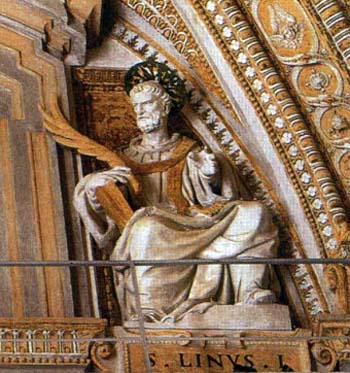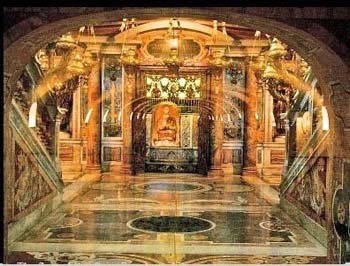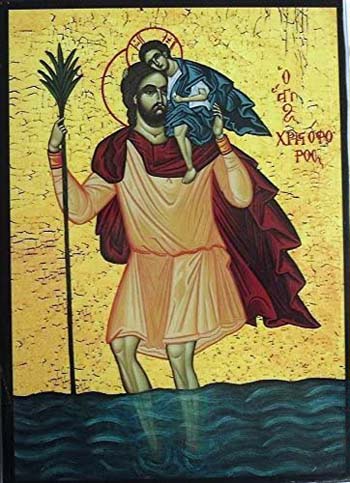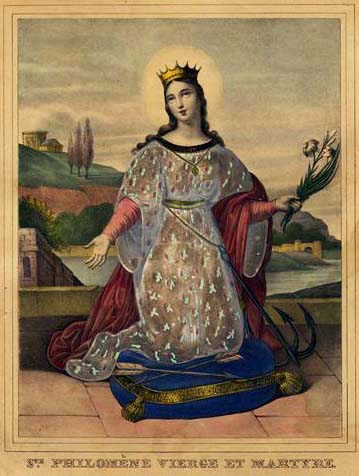The Saint of the Day
 |
 |
 |
 |
 |
 |
 |
St. Linus, Pope - September 23
Biographical selection:
In his Liturgical Year, Dom Guéranger comments on the second Pope St. Linus:
 "The lives of the first Vicars of Christ are buried in a mysterious obscurity, just as the foundations of a monument built to defy the ravages of time are concealed from view. To be the supports of the everlasting Church is a sufficient glory: sufficient to justify our confidence in them and to awaken our gratitude. It suffices for us to rejoice with the Church on this Feast, and pay our loving veneration to the humble and gentle Pontiff, who was the first laid to rest beside St. Peter in the Vatican crypts."
"The lives of the first Vicars of Christ are buried in a mysterious obscurity, just as the foundations of a monument built to defy the ravages of time are concealed from view. To be the supports of the everlasting Church is a sufficient glory: sufficient to justify our confidence in them and to awaken our gratitude. It suffices for us to rejoice with the Church on this Feast, and pay our loving veneration to the humble and gentle Pontiff, who was the first laid to rest beside St. Peter in the Vatican crypts."
"The Liber Pontificalis tells us that St. Linus was born at Volterra in Tuscany and that he was the first to succeed St. Peter. He occupied the Pontifical Throne from the year 65 to around 76 AD in the time of Nero. He died a martyr and was buried in the Vatican near the Sepulcher of Peter.
"Since there is a dearth of documents on the life of St. Linus, the fact that he was chosen to succeed St. Peter during Nero's terrible persecution guarantees us of his eminent sanctity and justifies the title of Martyr with which he is honored."
Comments of Prof. Plinio:
The thinking of Dom Guéranger is filled with faith and is very beautiful. He notes that almost nothing is known about the first Popes. St. Linus was the second Pope, the first after St. Peter. He was the first to be buried alongside St. Peter in the Vatican and the first to join St. Peter in Heaven.
We know, he says, that he was celebrated as a Martyr, but it seems that even how and where his martyrdom took place is unknown.
 So, what can be said about this Saint, since we have a pious need to know something about each Saint who is in Heaven? The answer he gives is very beautiful.
So, what can be said about this Saint, since we have a pious need to know something about each Saint who is in Heaven? The answer he gives is very beautiful.
Dom Guéranger says that the heavier the load a monument will bear, the greater and strong its foundation must be. So, even though we do not see the foundation, by the size of the monument we can calculate the depth and strength of the foundation.
This applies to the first Popes of the Church. The facts are obscure and very ancient: It was the time of persecution in the early Church and, therefore, the system of taking notes, preserving records, collecting the biographical data of the Popes was not yet organized.
However, the faithful have venerated St. Linus as a Saint since those times. He was part of that long chain of Saint Popes who came after St. Peter and who constitute the foundation of the Papacy.
Therefore, we can have trust that he must have been a man of eminent holiness and we should pay him all the respect and veneration that a Saint deserves.
This consideration is very beautiful because it is imbued with confidence in the Catholic Church, which has nothing to do with that foolish historical criticism that demands there must be a document or original source to believe in anything. This is nothing but the expression of unintelligence, of a rigid and narrow mind, and the absence of good spirit.

 On the contrary, to believe what the Church always believed is an approach filled with faith and superior intelligence. In summary, it is to accept the sanctity of St. Linus by the imponderable signs that were so well enunciated by Dom Guéranger.
On the contrary, to believe what the Church always believed is an approach filled with faith and superior intelligence. In summary, it is to accept the sanctity of St. Linus by the imponderable signs that were so well enunciated by Dom Guéranger.
Thus, with an act filled of confidence, we can say: "Since he was venerated as Saint by the faithful, and the Church admitted him to the altar as a Saint, he has to be Saint. Besides, St. Linus is one of the living stones of that long series of Popes – all Saints – that came after St. Peter. Therefore, he was a Saint and we, filled with an architectonic Catholic sense, honor him with the homage of our veneration."
This reasoning teaches us how we should behave in the face of situations and facts of the Holy Church. These things that are related to the Church very often have something mysterious, which is inherent to everything that is profoundly true.
The truths that are very transparent, very accessible to our minds, are second class stars in the firmament of truth. The first class stars are those that we perceive to be true, but are not straightforwardly demonstrable. They are credible for collateral motives, architectonic reasons, and it is by a series of circumstances that the Catholic believes in them. This is to believe in a superior way. This is what we should want to do. This is the approach we must take in the face of countless facts and situations of the Catholic Church.
I say this because you will have to face this problem, perhaps in a time not so distant. We are in a general reform of the Church and there are progressivists who are raising doubts about the existence of this of that saint, some who perhaps were not canonized by a process but simply admitted by the Church as saints based on the veneration of the faithful throughout the centuries.
I think that it is good spirit is to do what Dom Géranger did. If St. Linus was venerated as a Saint throughout the centuries, he existed and was a Saint. It is against Catholic sense and the sense of proportion to doubt this fact.
This position of soul opens horizons that go beyond the biography of St. Linus. It is to understand with what tact, and sense of mystery – which is the greatest sense of the intelligence and of the faith – we should deal with things like these.


The Saint of the Day features highlights from the lives of saints based on comments made by the late Prof. Plinio Corrêa de Oliveira. Following the example of St. John Bosco who used to make similar talks for the boys of his College, each evening it was Prof. Plinio’s custom to make a short commentary on the lives of the next day’s saint in a meeting for youth in order to encourage them in the practice of virtue and love for the Catholic Church. TIA thought that its readers could profit from these valuable commentaries.
The texts of both the biographical data and the comments come from personal notes taken by Atila S. Guimarães from 1964 to 1995. Given the fact that the source is a personal notebook, it is possible that at times the biographic notes transcribed here will not rigorously follow the original text read by Prof. Plinio. The commentaries have also been adapted and translated for TIA’s site.
In his Liturgical Year, Dom Guéranger comments on the second Pope St. Linus:

Pope St. Linus, the first successor of St. Peter
"The Liber Pontificalis tells us that St. Linus was born at Volterra in Tuscany and that he was the first to succeed St. Peter. He occupied the Pontifical Throne from the year 65 to around 76 AD in the time of Nero. He died a martyr and was buried in the Vatican near the Sepulcher of Peter.
"Since there is a dearth of documents on the life of St. Linus, the fact that he was chosen to succeed St. Peter during Nero's terrible persecution guarantees us of his eminent sanctity and justifies the title of Martyr with which he is honored."
Comments of Prof. Plinio:
The thinking of Dom Guéranger is filled with faith and is very beautiful. He notes that almost nothing is known about the first Popes. St. Linus was the second Pope, the first after St. Peter. He was the first to be buried alongside St. Peter in the Vatican and the first to join St. Peter in Heaven.
We know, he says, that he was celebrated as a Martyr, but it seems that even how and where his martyrdom took place is unknown.

The Chapel where St. Peter's bones are;
St. Linus was buried next to him
Dom Guéranger says that the heavier the load a monument will bear, the greater and strong its foundation must be. So, even though we do not see the foundation, by the size of the monument we can calculate the depth and strength of the foundation.
This applies to the first Popes of the Church. The facts are obscure and very ancient: It was the time of persecution in the early Church and, therefore, the system of taking notes, preserving records, collecting the biographical data of the Popes was not yet organized.
However, the faithful have venerated St. Linus as a Saint since those times. He was part of that long chain of Saint Popes who came after St. Peter and who constitute the foundation of the Papacy.
Therefore, we can have trust that he must have been a man of eminent holiness and we should pay him all the respect and veneration that a Saint deserves.
This consideration is very beautiful because it is imbued with confidence in the Catholic Church, which has nothing to do with that foolish historical criticism that demands there must be a document or original source to believe in anything. This is nothing but the expression of unintelligence, of a rigid and narrow mind, and the absence of good spirit.

Progressivists show bad spirit by removing Saints like Christopher & Philomena due to lack of documents

Thus, with an act filled of confidence, we can say: "Since he was venerated as Saint by the faithful, and the Church admitted him to the altar as a Saint, he has to be Saint. Besides, St. Linus is one of the living stones of that long series of Popes – all Saints – that came after St. Peter. Therefore, he was a Saint and we, filled with an architectonic Catholic sense, honor him with the homage of our veneration."
This reasoning teaches us how we should behave in the face of situations and facts of the Holy Church. These things that are related to the Church very often have something mysterious, which is inherent to everything that is profoundly true.
The truths that are very transparent, very accessible to our minds, are second class stars in the firmament of truth. The first class stars are those that we perceive to be true, but are not straightforwardly demonstrable. They are credible for collateral motives, architectonic reasons, and it is by a series of circumstances that the Catholic believes in them. This is to believe in a superior way. This is what we should want to do. This is the approach we must take in the face of countless facts and situations of the Catholic Church.
I say this because you will have to face this problem, perhaps in a time not so distant. We are in a general reform of the Church and there are progressivists who are raising doubts about the existence of this of that saint, some who perhaps were not canonized by a process but simply admitted by the Church as saints based on the veneration of the faithful throughout the centuries.
I think that it is good spirit is to do what Dom Géranger did. If St. Linus was venerated as a Saint throughout the centuries, he existed and was a Saint. It is against Catholic sense and the sense of proportion to doubt this fact.
This position of soul opens horizons that go beyond the biography of St. Linus. It is to understand with what tact, and sense of mystery – which is the greatest sense of the intelligence and of the faith – we should deal with things like these.

 | |
|
|
The texts of both the biographical data and the comments come from personal notes taken by Atila S. Guimarães from 1964 to 1995. Given the fact that the source is a personal notebook, it is possible that at times the biographic notes transcribed here will not rigorously follow the original text read by Prof. Plinio. The commentaries have also been adapted and translated for TIA’s site.


